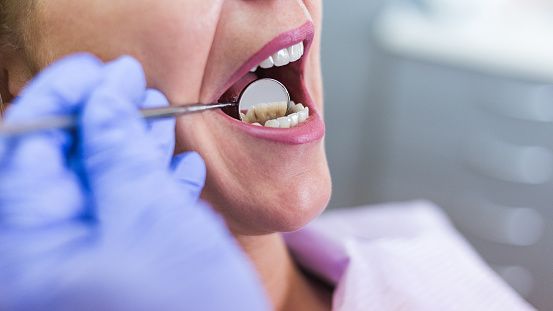Oral Cancer Screening
Lacey, WA
 Cancer is one of the biggest scourges on earth today, with over 14 million new cases being diagnosed yearly. One of the most common cancers is oral cancer, which affects not only the mouth but also the lips and tongue. The most common type of oral cancer is squamous cell carcinoma (SCC). SCCs are often slow growing but can spread to other parts of the body if not treated right away. Here at Karl Hoffman Dentistry, we are well versed with the different types of oral cancer and the treatment options available and we'll look for signs of oral cancer during your dental cleaning and dental exam. Cancer is one of the biggest scourges on earth today, with over 14 million new cases being diagnosed yearly. One of the most common cancers is oral cancer, which affects not only the mouth but also the lips and tongue. The most common type of oral cancer is squamous cell carcinoma (SCC). SCCs are often slow growing but can spread to other parts of the body if not treated right away. Here at Karl Hoffman Dentistry, we are well versed with the different types of oral cancer and the treatment options available and we'll look for signs of oral cancer during your dental cleaning and dental exam.
Oral Cancer Types and Treatment Options
There are four types of oral cancer. The first one is Squamous cell carcinoma (SCC), the most common type. They arise from the squamous cells that line the mouth, lips, and tongue surfaces. The next type is Adenocarcinoma which starts in epithelial tissues such as those found in saliva glands or the lining of specific cheek tissues.
The third type is Melanoma which arises from melanocytes, cells that give skin its color. It’s less common than SCC or Adenocarcinoma, but it can be more dangerous because it can spread quickly to other parts of the body. Lastly, Basal cell carcinoma (BCC) starts in basal cells, a type of cell found in the deepest layer of skin. BCCs are also slow-growing and rarely spread to other parts of the body.
Treatment Options
Early diagnosis is key to the successful treatment of all types of oral cancer. Here are the various treatments available.
Surgery
The first line of treatment for most patients with oral cancers will include surgery to remove tumors, reduce any visible evidence left after excision or debulk large tumors that have not responded well to other forms of treatment. This may be followed by local radiation therapy or chemotherapy, depending on tumor size and location.
Radiation Therapy
This can be used either as a stand-alone modality outside the surgical setting, combined with surgery (postoperative radiotherapy), or postoperatively within an existing wound site following surgical resection. Radiation therapy uses high-energy x-rays to kill cancer cells and shrink tumors.
Chemotherapy
This may be given as an injection or infused into a vein (intravenously) and taken orally called systemic chemotherapy, which circulates through the bloodstream and is intended to treat metastasis in distant organs such as bones, lungs, and brain. Chemotherapy uses potent chemicals that can stop both healthy and cancerous cell division, especially those that divide quickly like normal cells in the bone marrow, digestive tract, and hair follicles.
Risk Factors for Oral Cancer
While the cause of oral cancer is not fully understood, certain risk factors increase a person’s chance of developing it. The most common risk factor is smoking tobacco and using chewing tobacco. Other risk factors include alcohol consumption, excessive sun exposure, human papillomavirus (HPV) infection, poor oral hygiene, and a diet low in fruits and vegetables.
Symptoms and Signs of Oral Cancer
Symptoms of oral cancer can be either non-specific or specific. Non-specific symptoms include but are not limited to unexplained, persistent mouth sore(s) that don’t heal within two weeks, a lump or sore anywhere in the mouth, difficulty chewing, speaking, and swallowing. Specific symptoms include but are not limited to white or red patches inside the mouth that don’t go away within two weeks, a bump or thickening on your gums which does not disappear after several weeks of thorough brushing with ADA-accepted fluoride toothpaste.
The medical team at Karl Hoffman Dentistry is available to answer any questions you may have about oral cancer. Call us on 360-539-3429 for an appointment today, and we will help get your questions answered or address any concerns you might have! |
